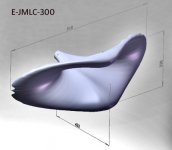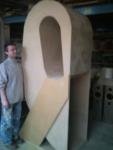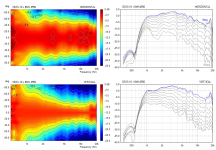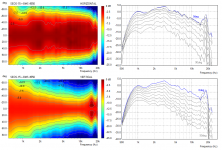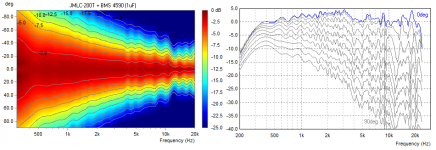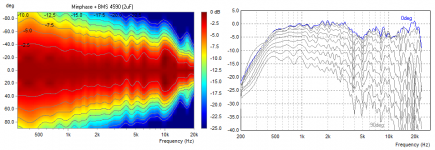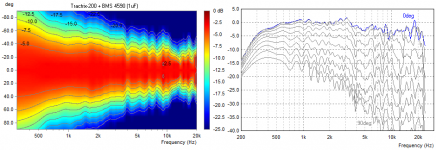Incredible looking speakers. I hope everyone liked them at the event.
The finish on them looks great and I can't wait to see the waveguides in person.
I've both seen and heard the Mumia's(the white speaker on the picture from the High End Praha 2011 picture on page 40, posted by jzagaja) at my dealer here in Denmark, and I was so impressed by the presentation - first and foremost the sound, but certainly also their very appearance and finish - that I immediately placed my order for a new pair in white. I'm now anxiously awaiting their arrival in some 3 weeks, or so I've been told
The version I heard was the "standard" version, with STX drive units and a system sensitivity of around 98dB, which is the very same version I've ordered. I've been informed though that a less sensititive bass driver is available in the system as well, delivering deeper bass, but, as mentioned, at the expense of sensitivity(around 95dB). I found the bass repsponse of the "standard" Mumia to be just the way I want, and therefore saw no reason for any changes. A BMS ringradiator is also optional, though not tested, instead of the STX compression driver I heard, but being that I loved the sound of the Mumia's in named "standard" configuration, that's where I left it.
If anybody is interested I'd be glad to elaborate on the sound of the Mumia's.
Last edited:
I've both seen and heard the Mumia's(the white speaker on the picture from the High End Praha 2011 picture on page 40, posted by jzagaja) at my dealer here in Denmark, and I was so impressed by the presentation - first and foremost the sound, but certainly also their very appearance and finish - that I immediately placed my order for a new pair in white. I'm now anxiously awaiting their arrival in some 3 weeks, or so I've been told
The version I heard was the "standard" version, with STX drive units and a system sensitivity of around 98dB, which is the very same version I've ordered. I've been informed though that a less sensititive bass driver is available in the system as well, delivering deeper bass, but, as mentioned, at the expense of sensitivity(around 95dB). I found the bass repsponse of the "standard" Mumia to be just the way I want, and therefore saw no reason for any changes. A BMS ringradiator is also optional, though not tested, instead of the STX compression driver I heard, but being that I loved the sound of the Mumia's in named "standard" configuration, that's where I left it.
If anybody is interested I'd be glad to elaborate on the sound of the Mumia's.
Please elaborate!
-Thanks
Roy
Please elaborate!I'm part of the latest Group Buy and future 12" OSWG owner. I take you were happy with the high frequency extension too. Did you notice any on axis response hole. Were the speakers toed in 45 degrees?
-Thanks
Roy
Hi Roy,
To more precisely pinpoint your question I must stress my impressions to be formed in the context of named STX compression driver(model D-800-8-Ti, modified after Auto-Tech's specifications), and a setup comprising NuForce Ref. 9V3SE mono poweramps, Blue Cheese Audio Rouqefort(combined DAC/Preamp), and Mundorf speaker- and IC-cables. Music files were "pulled" from a harddisk in wav-format, the media player being J River MC15.
The Mumia's were placed rather close to each other for practical reasons, in that they were slightly flanked by the existing (and big!) speakers of the setup, and therefore only very mild toe-in was applied. I guess you're referring to the sweet-spot widening with the axis crossing in front of you(with 45 degree toe-in), a trick to be achieved with the CD-waveguides, but that wasn't tested here. That is, the Mumia's in named setup didn't even fire directly towards the ears.
I've never experienced compression driver driven speakers in a home setup, only at hifi-exhibitions here and there, so what I heard was quite unlike what my ears are used to - and this, after a little getting-used-to, is to be understood in a positive way. What struck me the most about the sound of the Mumia's, when focusing on the middle to upper regions, was (a mixture of) the level of resolution, detail, physicality, effortlessness, dynamics, direct-ness, subtleness, transient-speed, textuality, and coherence. Information was suddenly noticable that I hadn't paid any attention to earlier, and there was a very hands-on or even tactile feeling of the music. Music seemed to be delivered in a more direct manner, though without being intrusive, and some music sounded very different from I'd gotten used to. However, rather quickly I had the feeling I was now hearing a more honest presentation. The music seemed to emerge through a holistic "framework" or sorts, yet at the same time, depending on the recording, the Mumia's managed to disappear effectively in the presentation when I closed my eyes, and hereby making invisible any spatial boundaries. In short, a quite staggering amount of sheer insight into the recordings, I'd say.
Above description may be misleading, perhaps having one believe this is a too-much shoveled-into-your-ears kinda sound, but that's hardly the case. As mentioned earlier the rather energy-poised presentation takes a little getting used to, but once past this what awaits is a very emotional reaction to the music(Kothbiro by Alberto Iglesias, from the Original Motion Picture Score to The Constant Gardener, was an overwhelming experience...), and I couldn't help but notice the real-ness of instruments and voices, as if these speakers provide them with the room to breath and bloom, if you will.
It's the sound of less restraintment and more reality, even though I'd argue it's as if the sense of reality enters not so much gradually compared to what I've heard before, but more like "now it seems real; earlier it didn't." Maybe it's the way the mind works, that there's a threshold of information of certain parameters that must be crossed, even though they're not completely representative of reality itself, that makes the mind suddenly accept them as "real." This may sound a little speculative, but just to unfold my thoughts in this regard...
What interests me about the sound of the "upper regions" is that it doesn't sound like that, in a way, but more like what it is - a physical presentation that is a mere extension upwards in frequency, and that is not least a lifelike re-presentation of a real instrument, voice, or whatever. In comparison most dome tweeter- or ribbon-based speakers I've heard sound more or less thin, compressed, and lacking the fullness, physicality, dynamics, and ease of the Mumia's presentation in this regard. Especially with regard to ease, physicality, coherence, dynamics, and transient speed - all very vital elements in making something sound "real" - I'd say nothing I've heard really bests the Mumia's, at least not with any considerable margin that would make me immediately notice them.
I didn't observe any "on axis response hole," or other anormalies as such. I'm quite sure though that the presentation of the Mumia's would've benefitted had they been placed further apart, and moreover they only had a few days of music in them when I listened to them. In the following two weeks since I'm told they've developed into being more "organic" and "delicious" in their sonic presentation, and the bass seems to have become deeper as well.
Hope this helps. If not, feel free to inquire further
Last edited:
Hi phusis,
Excellent "review"!
What woofer is in the Mumia's? Do you know how the compression drivers were modified?
Thanks
You're welcome, Roy
I don't know the specifics/nature of the modifications of the STX compression driver used in the "standard" Mumia's, nor the woofers, but I do know the woofer used, in the outset before modification for the standard Mumia, is the model STX GDN-30-400-8-SE:
GDN-30-400-8-SE - Kino domowe, g?o?niki, kolumny - STX polski producent
The bass reproduction of the standard Mumia's is super tight, clean, and fast. It matches extremely well with the STX compression driver, I find, which is why I decided to order a new pair of this particular "standard" edition.
PS. I must stress that there's nothing standard, as in mediocre, about the "standard" Mumia's I'm referring to. I'm only referring to them as "standard" because there are options besides this edition, which naturally have to be specified, to be had with regard to the choice of drivers, crossover components, bottom plate, etc., and some of these options, where they have sonic impact, are not yet tested(like the BMS ringradiator). There are different colors to be had, of course, but to my knowledge there's no standard color as such - or if there is I would guess it's white
Last edited:
Compression Drivers + Power AmpsWith care, bass and mid-range drivers usually have a very long lifespan, but compression drivers wear out relatively quickly. You can't move bits of metal that fast without mechanical fatigue eventually becoming a problem. That's why most, if not all designs, have replaceable diaphragm assemblies. Good designs, well looked after, might survive four or five years with average use, while poorer designs will typically fail after just one or two years — and excessive power levels, amplifier clipping, and being driven with frequencies below their design limits will all speed up that process dramatically.
The above stated, rather limited projected lifespan of a compression driver mayn't apply with regard to use in the generally less demanding(max SPL) domestic-, or "hifi"-domain, but still, would one have to worry, particular in the case of Auto-Tech's Mumia speakers just mentioned above, about the (STX) compression drivers lifespan in normal use? I'm guessing the lifespan also differs to some extend depending on the brand and the type of diaphragm material used.
I'm new to compression driver driven speakers - in fact, I'm still awaiting my first pair to arrive - so I enter this sans experience to draw from. Perhaps people who have used compression driver driven speakers for years are familiar with the limited lifespan of this type of driver, and therefore feels no need to question this any further as it's just become an accepted fact/shortcoming. It may also be - in that this subject is rarely spoken of or addressed, as far as I can discern - that there's really no issues at all, and that compression drivers in hifi-setups face no problems with regard to lifespan or reliability compared to more conventional HF-drivers.
I'm just curious about this now that I'm about to gain personal experience with compression drivers, hopefully only with regard to their sonic strenghts or characteristics, so any inputs on this particular (non-)issue are welcome...
Best,
M
Last edited:
I am not sure where this notion is coming from about compression drivers having a limited life span in home use.
Klipsch speakers have compression loaded mids and highs and sometimes compression loaded woofers and they will last for decades. BTW, these are not using very expensive components either.
Similar statements can be made for the old Altec stuff etc.
Klipsch speakers have compression loaded mids and highs and sometimes compression loaded woofers and they will last for decades. BTW, these are not using very expensive components either.
Similar statements can be made for the old Altec stuff etc.
I am not sure where this notion is coming from about compression drivers having a limited life span in home use.
Klipsch speakers have compression loaded mids and highs and sometimes compression loaded woofers and they will last for decades. BTW, these are not using very expensive components either.
Similar statements can be made for the old Altec stuff etc.
There's no "notion" other than the quoted text, and my question as to whether the context of this text is exclusive to the matter of lifespan in compression drivers.
Some Klipsch compression drivers use phenolic diaphragms, which may be less liable to deteriorate the same way titanium and aluminium does, but I don't know about the Altec drivers.
I'm not stating there are problems with the lifespan of compression drivers for home use, but only, in light of the quoted text, whether there could be any problems.
If there aren't, I'd be all the happier
Hi,
Is this a horn for a 1" or a 2" driver ?
Thanks.
2" driver.
- Home
- Group Buys
- Waveguides and horns
